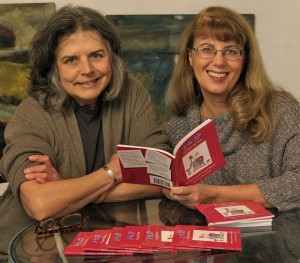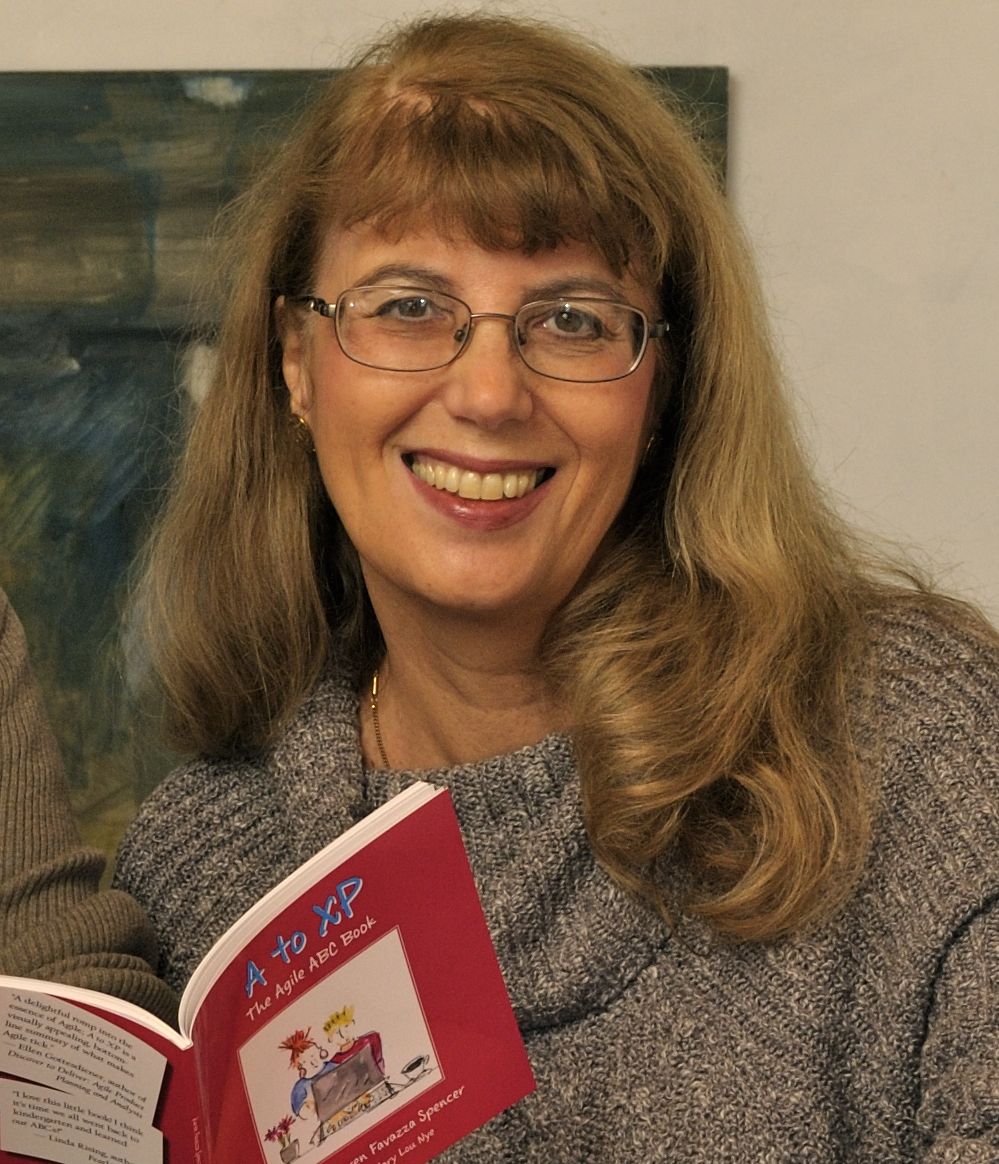Bloomberg Businessweek and The Agile ABC Book
December 18, 2012
Two produce primer on Agile management
By Joann Mackenzie
Staff Writer
—- — Now, just in time for Christmas, comes what its creator, Gloucester resident Karen Favazza-Spencer, describes as “the perfect Scrum stocking stuffer for college kids outbound for the corporate workplace.”

Lee Nadel/Courtesy photo: Mary Lou Nye, left, and Karen Favazza Spencer with their new book, “A to XP: The Agile ABC Book”
We are talking about Favazza-Spencer’s new self-published paperback, “A to XP, The Agile ABC Book” — 58 colorfully, whimsically illustrated pages, which the author, a former kindergarten teacher, conceived in partnership with fellow Gloucesterite and graphic artist Mary Lou Nye, as “a simple guide book, a “kindergarten-esque” primer for 21st century business — “Cliff Notes, really, that anyone can understand” to aid them in their inner journey toward high performance transformation through the corporate/tech project management model known as “Agile.”
Those among us who are a bit behind the corporate/tech curve, “Agile” —a culture unto itself with its own, frankly, highfalutin’ language— might also need something along the lines of an “Agile” translator; something which, thankfully, Favazza-Spencer is all to happy to serve as.
“Agile,” she explains, evolved out of tech development complexities that were already presenting problems to software engineers in the early 1990s. Back then, while the rest of us were asking, “What is software?,” the big brains who birthed the big bang of the tech revolution were already asking themselves, “How are we going to manage the process of product development given the nature of the rapidly, ever-changing evolution of software?”
The answer, says Favazza-Spencer, formulated itself in February 2001, when a group of 17 tech thought leaders gathered at a ski lodge in Utah to find a common ground and approach toward what by then was called “Extreme Programming.” What emerged from that gathering was “The Agile Manifesto” and in the tech world, it and its authors (“Agilists”) quickly came to be regarded with all the sanctity of the Declaration of Independence and its authors.
Originally, “The Agile Manifesto” billed itself as a formal proclamation of four key values and 12 principles to guide an “iterative and people-centric approach to software development.” Although its objective, says Favazza-Spencer was to humanize, simplify and “make the collaborative team process of software development more transparent,” its vocabulary may strike newcomers as anything but any of those things.
Iterative, empirical, lean, radiator, lean concepting, value stream mapping, pull processing, transformational journey, etc., are not just key PowerPoint words and presentation phrases, but common everyday parlance in the world of Agile, which is conducted in ‘sprints’ by “scrums” (abbreviated from Rugby scrummage) under the direction of certified ‘scrum masters’ who implement options such as ‘satisficing’ to ensure that boundaries around role and responsibility establish the Agile playing field.
If the objective of “Agile” is to simplify and humanize the collaborative work process, why, one might ask, do “Agilists’” obscure it with such lexicon and frankly elitist words such as “iterative” and “empirical?” Favazza-Spencer laughs at the question, and answers, “Well, its authors were, of course, engineers and academics.”
While one might argue over lexicon, there is no arguing with success, and the fact is that “Agile” has succeeded beyond the wildest imaginings of its Agilist authors as a mainstay in today’s team-centric business environment. Quickly adopted from the tech sector and adapted as a model for project management in specialized corporate sectors such as marketing — “Agile” has by now spread like wildfire throughout all sectors of the global corporate workplace. (Ask Google if Apple is an Agile culture and a recent Forbes article will pop up with the answer: “yes”)
Favazza-Spencer, who stumbled out of the world of teaching into the world of tech back in the mid-’90s, “on the cusp of the World Wide Web,” when she realized that she was “tech intuitive” is herself now a “certified Scrum master.” It is a very lucrative thing to be these days, she says, adding that a recent six-month assignment with a company in Idaho enabled her to self-publish “A to XP, The Agile ABC Book” in time for Christmas.
“Really,” she says of her “Scrum stocking stuffer ,” “Agile may sound complicated, but this little primer shows you how simple and transformational it really is.”
Or, perhaps more to the point, how much it’s become the signature way of doing business in the tech-transformed 21st century. That, as they say, is the bottom line, and why parents might want to move “A to XP, The Agile ABC Book” to the top of their college kids’ stocking stuffers lists.
Joann Mackenzie may be contacted at 978-283-7000, or jomackenzie@gloucestertimes.com.
Originally printed in the Gloucester Times. Reprinted by Bloomberg Businessweek, Information Technology Sector. December 18, 2012.
A to XP, Bloomberg, Business, The Agile ABC Book




